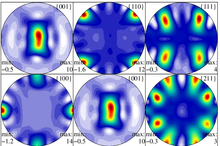Titanium aluminide
Titanium aluminide, TiAl, is an intermetallic chemical compound. It is lightweight and resistant to oxidation [1] and heat, however it suffers from low ductility. The density of gamma TiAl is about 4.0 g/cm³. It finds use in several applications including automobiles and aircraft. The development of TiAl based alloys began about 1970; however the alloys have only been used in these applications since about 2000.
Applications

Titanium aluminide has three major intermetallic compounds: gamma TiAl, alpha 2-Ti3Al and TiAl3. Among the three, gamma TiAl has received the most interest and applications. Gamma TiAl has excellent mechanical properties and oxidation and corrosion resistance at elevated temperatures (over 600 degrees Celsius), which makes it a possible replacement for traditional Ni based superalloy components in aircraft turbine engines.
TiAl based alloys have a strong potential to increase the thrust-to-weight ratio in the aircraft engine. This is especially the case with the engine's low pressure turbine blades and the high pressure compressor blades. These are traditionally made up of Ni-based superalloy, which is nearly twice as dense as TiAl based alloys.
General Electric has recently announced that gamma TiAl low pressure turbine blades will be used on its GEnx engine, which powers the Boeing 787 and Boeing 747-8 aircraft. This is the first large-scale use of this material on a commercial jet engine. The TiAl LPT blades are cast by Precision Castparts Corp. and Avio s.p.a.. Machining of the Stage 6, and Stage 7 LPT blades is performed by Moeller Manufacturing, Aerospace Division, in Wixom, Michigan, USA. An alternate pathway for production of the gamma TiAl blades for the GEnx and GE9x engines using Additive Manufacturing is also being explored.[3]
References
- ↑ "Preferential formation of Al self-interstitial defects in γ-TiAl under irradiation". Intermetallics. 32: 230–232. doi:10.1016/j.intermet.2012.07.026.
- ↑ Liss KD, Bartels A, Schreyer A, Clemens H (2003). "High energy X-rays: A tool for advanced bulk investigations in materials science and physics". Textures Microstruct. 35 (3/4): 219–52. doi:10.1080/07303300310001634952.
- ↑ http://3dprint.com/12262/ge-ebm-3d-printing/
External links
- Machining Gamma Titanium Aluminide Components - Moeller Manufacturing
- Titanium Aluminide Applications in the HighSpeed Civil Transport
- Titanium Aluminides - Intermetallics on azom.com.
- Power House (GEnx TiAl LPT Blade Announcement)
- Edward A. Loria (2001). "Quo vadis gamma titanium aluminide". Intermetallics. 9 (12): 997–1001. doi:10.1016/S0966-9795(01)00064-4.
- Donachie, Matthew J (2000). Titanium: a technical guide. p. 131. ISBN 978-0-87170-686-7.
- Kassner, Michael E; Pérez-Prado, María-Teresa (2004). Fundamentals of creep in metals and alloys. p. 175. ISBN 978-0-08-043637-1.